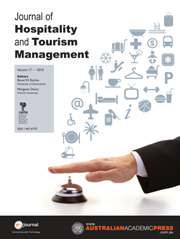Crossref Citations
This article has been cited by the following publications. This list is generated based on data provided by
Crossref.
Ormond, Meghann
2014.
The Wiley Blackwell Companion to Tourism.
p.
425.
Small, Jennie
and
Harris, Candice
2014.
Crying babies on planes: Aeromobility and parenting.
Annals of Tourism Research,
Vol. 48,
Issue. ,
p.
27.
Wu, Hung-Che
and
Ai, Chi-Han
2016.
Synthesizing the effects of experiential quality, excitement, equity, experiential satisfaction on experiential loyalty for the golf industry: The case of Hainan Island.
Journal of Hospitality and Tourism Management,
Vol. 29,
Issue. ,
p.
41.
Silva, Talita Naiara Rossi da
Guarda, Jerusa Barbosa de Souza
Silva, Larissa Lunardon Gomes da
Figueiredo, Julia Pierre
and
Menegon, Nilton Luiz
2016.
Passageiros com deficiência no transporte aéreo brasileiro: diferentes atores, perspectivas semelhantes.
Gestão & Produção,
Vol. 24,
Issue. 1,
p.
136.
Campese, Carina
Silva, Talita Naiara Rossi da
Silva, Larissa Lunardon Gomes da
Figueiredo, Julia Pierre
and
Menegon, Nilton Luiz
2016.
Assistive technology and passengers with special assistance needs in air transport: contributions to cabin design.
Production,
Vol. 26,
Issue. 2,
p.
303.
Wilton, Robert
Hansen, Stine
and
Hall, Edward
2017.
Disabled people, medical inadmissibility, and the differential politics of immigration.
Canadian Geographies / Géographies canadiennes,
Vol. 61,
Issue. 3,
p.
389.
Nyman, Emma
Westin, Kerstin
and
Carson, Doris
2018.
Tourism destination choice sets for families with wheelchair-bound children.
Tourism Recreation Research,
Vol. 43,
Issue. 1,
p.
26.
Tao, Bruce Changjiang
Goh, Edmund
Huang, Songshan (Sam)
and
Moyle, Brent
2019.
Travel constraint perceptions of people with mobility disability: a study of Sichuan earthquake survivors.
Tourism Recreation Research,
Vol. 44,
Issue. 2,
p.
203.
Major, Wesley L.
and
Hubbard, Sarah M.
2019.
An examination of disability-related complaints in the United States commercial aviation sector.
Journal of Air Transport Management,
Vol. 78,
Issue. ,
p.
43.
da Silva, Talita Naiara Rossi
de Souza, Jerusa Barbosa Guarda
Camarotto, João Alberto
and
Menegon, Nilton Luiz
2019.
Proceedings of the 20th Congress of the International Ergonomics Association (IEA 2018).
Vol. 824,
Issue. ,
p.
1747.
McIntosh, Alison J.
2020.
The hidden side of travel: Epilepsy and tourism.
Annals of Tourism Research,
Vol. 81,
Issue. ,
p.
102856.
Gillovic, Brielle
and
McIntosh, Alison
2020.
Accessibility and Inclusive Tourism Development: Current State and Future Agenda.
Sustainability,
Vol. 12,
Issue. 22,
p.
9722.
Boo, Soyoung
and
Kim, Miyoung
2020.
Disability accommodations at meetings and events: Text mining and document analysis.
Journal of Convention & Event Tourism,
Vol. 21,
Issue. 4,
p.
331.
Budd, Lucy
and
Ison, Stephen
2020.
Supporting the needs of special assistance (including PRM) passengers: An international survey of disabled air passenger rights legislation.
Journal of Air Transport Management,
Vol. 87,
Issue. ,
p.
101851.
Carneiro, Maria João
Teixeira, Leonor
Eusébio, Celeste
Kastenholz, Elisabeth
and
Moura, Andreia Antunes
2021.
ICT Tools and Applications for Accessible Tourism.
p.
74.
Nazari Orakani, Solmaz
Smith, Karen
and
Weaver, Adam
2021.
Reframing the experiences of travellers with mobility impairments: Enhancing the leisure constraints model.
Journal of Hospitality and Tourism Management,
Vol. 47,
Issue. ,
p.
84.
da Silva, Flávia Helen Moreira
Sticca, Marina Greghi
da Silva, Talita Naiara Rossi
Vidotti, Heloisa Giangrossi Machado
and
Menegon, Nilton Luiz
2021.
Proceedings of the 21st Congress of the International Ergonomics Association (IEA 2021).
Vol. 219,
Issue. ,
p.
288.
GÜL, Tolga
2021.
TURİST OLARAK “ENGELLİ” ALGISI, TURİST REHBERLERİ ÜZERİNE BİR ÇALIŞMA.
Sosyal Politika Çalışmaları Dergisi,
Vol. 21,
Issue. 52,
p.
575.
Evans, Bethan
Bias, Stacy
and
Colls, Rachel
2021.
The Dys-Appearing Fat Body: Bodily Intensities and Fatphobic Sociomaterialities When Flying While Fat.
Annals of the American Association of Geographers,
p.
1.
Eusébio, Celeste
Teixeira, Leonor
Moura, Andreia
Kastenholz, Elisabeth
and
Carneiro, Maria João
2021.
Advances in Tourism, Technology and Systems.
Vol. 208,
Issue. ,
p.
120.




